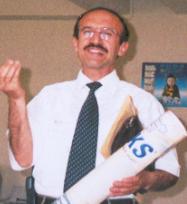
All rights reserved.
Indian Journal of Chemistry
Vol. 39B, August 2000, pp. 629 - 633

Synthesis of allyl-cyclopropyl alcohols and allyl-l,5-hexadien - 3- ols and investigation of their antibacterial and antifungal activities
S Servi , A Cansiz, M Digrak*, & M Ahniedzade
Department of Chemistry Firat University, 23169 Elazig /TURKIYE
*Department of Biology K.S.U.University, 46000 K.Maras /TURKIYE
Received 18 December 1997; accepted (revised) 11 April2000
Abstract
Two different methods have been used to obtain allyl-cyclopropyl alcohols and allyl- I ,5-hexadien - 3 - ols, starting with various al[yl substituted chloromethyloxiranes. While allyl substitued 1,5 - hexadien - 3 - ols are formed in reactions occuning with Mg in THF, the unsaturated cyclic alcohols are also formed. However, the reaction carried out with Na in CH3OH gives only 1,5 - dien - 3 - ols. Antimicrobial activity of the synthesised compounds has been tested against 16 microorganisms. The compounds have also been screened for their antibacterial and antifungal activities against bacteria, yeasts and moulds.
Synthesis of 1,5-dien-3-ols requires many steps as reported in literature. Three different methods have been used. One of the methods involves the preparation 1 ,5-dien-3-ols by Grignard reaction of unsaturated carbonyl compounds ‘~ with allylmagnesium halides or vinylmagnesium halide. In the second method four new sigmatropic sequences triggered by regio-controlled [2, 3] - Witting rearrangement of unsymetrical bis allylic ethers to 1 ,5-dien -3-ols have been synthesised68. In the third one 1 ,5-dien 3- ols have been prepared by reduction of unsaturated epichlorohydrin compounds9.
1,5-Dien-3-ols have been useci in tne synthesis of insect pheromones and antibiotics. Yamada et al.’0 have isolated (d)-dictyoprolene as 1 ,5-dien-3 -ol as acetate from Dictyopteris proljfera and its structure was deduced from spectroscopic methods. Vig et. al.” have synthesised dictoprolen& in laboratory. (4E-7E)-Tridecadin- 1 -yl acetate is a known pheromone of Zepidoptera gelcehirada known as potato wonn. This pheromone was synthesised starting from 1,5 (2)-undecadien-3-ol by Chattopadhayay et al’2.
In the present study allyl substitued chloromethyloxiranes were prepared by condensation of olefins with dichloro-carbonyl compounds in the presence of a Lewis acid catalyst’3. Allyl (2d, 2e, 4), unsaturated cyclic alcohols (3e and 5) and 1,5 - dien -3 - ols (2a, 2b, and 2c) were synthesised by two different methods (Scheme 1, Table I).
The newly syntttesised 2b, 2d and other compounds were charactarised by ‘H, ‘3C NMR, FlIR, microanalyses .The reaction with Mg in THE may take place in the same way as Grignard reaction. In this reaction, the C-O bond in epoxide ring splits up with two different arrangements in molecules leading the formation of two different types of alcohols.
In literature, the reaction of carbonyl compounds with Grignard reactives gives I ,5-hexadiene-3-ols in 70-85 % yields, but sigmatropic rearrangement of bis allylic ethers gives 1,S-hexadien-3-ols 60-88 % yields .ln this study, yields of alcohols using both methods (A and B) were generally 62-76 %. The yields of synthesised alcohols by method- B were higher than those by method- A. The ratio of cyclic alcohols to l,5-hexadien-3-ols was 40:60.
Antibacterial and antifungal activities
In this study, Escherichia coli DM, Enterobacter aerogenes CCM 2531, Klebsiella pneumoneae FMC, Micrococcusr lutes LA, Bacillus cereus FMC 19, Bacillus megaterium DSM 32, Bacillus subtilis 1M6 22, Pseudomanas aeruginosa DSM 50071, Pseudomonas fluoroscens FMC 39, Streptococcus sp, Staphylococcus aureus COWAN 1, Listeria monocyto genes A have been used as bacteria, Saccharomyces cerevisiae UGA 102, Candida albicans CCM 314, Alternaria soloni and Aspergillus flavus as yeasts and moulds. Antibacterial and antifungal activity data are given in Table II.
The compounds checked the growth of Gram (±) and Gram (-) bacteria at different concentrations. In general their antimicrobial effects were determined at 100 —600 j.i.g. disk concentration (low antimicrobial effects at 100 ~.tg I disk concentration). Significant antimicrobial activity was observed against M luteus